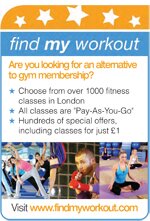 Aerobic Training Variables – things we can change about the way we do our cardio.
Aerobic Training Variables – things we can change about the way we do our cardio.
As with resistance training, there are a number of things we can do to make our cardiovascular exercise more productive and therefore improve our aerobic fitness to new higher levels. By implementing the following, we can make sure that the dreaded plateau is a thing of the past.
- Frequency – exercise more often
- Intensity – work at a higher percentage of maximum Heart rate
- Duration – exercise for longer periods of time/cover greater distances
- Speed – run/cycle/swim/step/row at a faster rate
- Intervals – employ interval training in place of steady state cardio*
- Terrain – run/walk/cycle on different surfaces
- Hill work – purposely seek out hillier routes to walk, cycle or run
- Modality – select different aerobic training methods e.g. run instead of swim
- Add resistance – use weighted vests, ankle weights or back packs
- Employ an aerobic training method – e.g. fartlek, FCR or LSD)**
*Interval training – periods of high intensity work interspaced with periods of low intensity recoveries e.g. run hard for 60 seconds, jog for 120 seconds and repeat
**Fartlek – mixed speeds within a training session performed randomly, FCR – Fast Continuous Running…aerobic exercise performed at high levels of intensity for shorter periods of time, LCD – Long Slow Distance…Continuous aerobic exercise performed at a comfortable pace for extended periods of time
As with our resistance training variables, it’s a good idea to focus on one or two of the above options for a few weeks before selecting other variables from the list. Trying to make too many changes at once is likely to be too dramatic a change and result in exhaustion and possibly injury. It is also worth bearing in mind that it is recommended that increases in duration/distance per workout and per training week be limited to approximately 10%. In other words, if your current longest run is 3 miles, don’t increase your mileage up to 4 miles over night but increase the distance to by around 400 – 500 metres to avoid potential overuse injuries.
“If we are going to succeed, we need to plan for success” & “Failing to plan is planning to fail”
Improvements in physical fitness don’t happen by accident. They are a direct result of the application of consistent and sustained effort, good eating habits and appropriate rest. If we have no real plan, we have much less chance of making the progress we are looking for.
When thinking about exercise, it’s necessary to think long term – not just tomorrow, next week or next month, but next year and the year after. How are you going to take your current level of exercise and fitness on from the here-and-now to your ultimate fitness goal? The answer is to make a plan.
They say a journey of a thousand miles starts with a single step, but if those initial steps are in the wrong direction then we’ll never get to our destination. It is necessary to “reverse engineer” our journey from where we want to be to where we are now so we can plot our route to ultimate success.
So – a few questions…write down the answers:
- What is your ultimate fitness goal? (lose fat, run a marathon, make it to the 1st team etc)
- Where are you currently in relation to your ultimate fitness goal? (score out of 10)
- How committed are you to achieving your goal? (score out of 10)
- How much time can you dedicate to your goal? (list the hours per week)
- What are the possible barriers you might encounter during your quest for success? (make a list)
- How can you remove those barriers? (write down solutions to the above list)
- What/who are your allies in reaching your goal? (Who can help you?)
Once you have answers for the above questions, you are well on your way to making a plan of battle to take you to your goal.
Next – we need to break down the ultimate fitness goal into smaller bite sized chunks. Our ultimate goal is probably a long term goal…months or possibly years away. That’s a very long time to remain motivated. To help keep us focused on the prize, it’s worth breaking our main goal down into several sub-goals which are more readily achievable.
To give you an example – let’s say your goal is to run a marathon (26 miles) but currently your longest run is 6 miles. That means you have to run a whole 20 miles further to reach you goal. For many people, that might seem like a daunting if not impossible task! Instead, let’s break that ultimate goal down into more manageable chunks…
1st sub goal – run 10 miles
2nd sub goal – run a half marathon (13 miles)
3rd sub goal – run 17 miles
4th sub goal – run 21 miles
Ultimate goal – run a marathon
By breaking down our ultimate goal into smaller bite sized chunks, we will experience numerous minor successes on the way to realisation of our end goal. This promotes adherence, maintains enthusiasm and improves our success potential dramatically.
To train smarter, think SMARTER!
Once you have decided upon your goals, apply the acronym SMARTER to them.
SMARTER stands for:-
Specific – put a numerical value to what you are trying to achieve
Measurable – make sure you can prove success by hitting numerical targets e.g. body fat %
Achievable – is your goal feasible? Do you have the necessary resources to allow success?
Realistic – can it be done in the time available? Are there many barriers to overcome?
Time bound – set a dead line when you expect to achieve success
Enjoyable – if it’s not you are less likely to stick to it
Recorded – write it all down, tell your friends, make your goals public property! It makes it much harder to drop out if you know people are interested in your progress!
By applying SMARTER to the goals we set for ourselves we improve the likelihood of succeeding massively.
Training Diaries – No more wasted workouts!
I am an absolute believer in the power of a training diary. I have kept training diaries for my entire exercising life and rely on them constantly to help me plan my next phase of training. A training diary will provide you with numerical evidence of previous workouts performed, allow you to track improvements, see what has worked well for you and what has been less successful, show consistency and highlight lapses as well as improving focus as you record your performance from workout to workout.
By making use of a training diary, you’ll never go into the gym and be saying to your self “Now, what shall I do today?” Every workout will be productive and specific to your goals.
Personally, I use A5 sized ring bound note books as training diaries although I know you can buy fancy programmes for your computer. Alternatively, if you are so inclined, you could even design excel spread sheets. Regardless of what method you choose, keeping a training diary is one of the most useful tools we have available to keep ourselves motivated and focused.
By utilizing the information in your training diary, you can plan your next workout based on how your previous workout went. Make a note of which exercises you performed, which exercises which need increased resistance, reps achieved with a given resistance, number of sets performed, rest intervals used, settings on cardio machines, durations and heart rates of CV exercise, total duration of each workout, how you felt etc. By having all this information to hand, we can use the training variables discussed earlier to push our selves onwards and upwards towards out ultimate fitness goals.
So, the take home points for continued exercise progress are:-
1) Whatever you are doing now, you need to change in the near future
2) Manipulate the training variables regularly to promote progression
3) Set goals and work towards them
4) Make long term plans for success
5) Keep a training diary to measure your success and keep you focused





















